The Western Movies Of Clint Eastwood
The cowboy star is a dying breed and Clint Eastwood is probably the last great Hollywood Western movie actor. His career mirrors that of John Wayne in that, although his films have encompassed a number of genres over the years, he will always be associated with the Western.
 If this were to be a complete and comprehensive appreciation of all the cowboy films Eastwood has appeared in since the beginning of his career I would have to include Star in the Dust and The First Travelling Saleslady, in which he played small bit parts, along with the low budget oater, Ambush at Cimarron Pass, where he featured third in the cast list.
If this were to be a complete and comprehensive appreciation of all the cowboy films Eastwood has appeared in since the beginning of his career I would have to include Star in the Dust and The First Travelling Saleslady, in which he played small bit parts, along with the low budget oater, Ambush at Cimarron Pass, where he featured third in the cast list.
I have decided to therefore concentrate only on the Westerns in which Clint played the lead role, from A Fistful of Dollars onwards, and keeping the list to a round ten.
This means I’ll not be reviewing The Beguiled, which I don’t consider to be a full-blown Western, more of an exercise in Southern Gothic melodrama. I’m also passing on Paint Your Wagon as well.
The sight (and sound) of Clint wandering the landscape warbling “I Talk to the Trees” has no place in the rugged company of films such as Hang ‘Em High and The Outlaw Josey Wales.
Besides, I don’t like musicals.
Just to point out that I’m going to review the films chronologically. I will, however, rate them by preference at the end of the second part of the article.
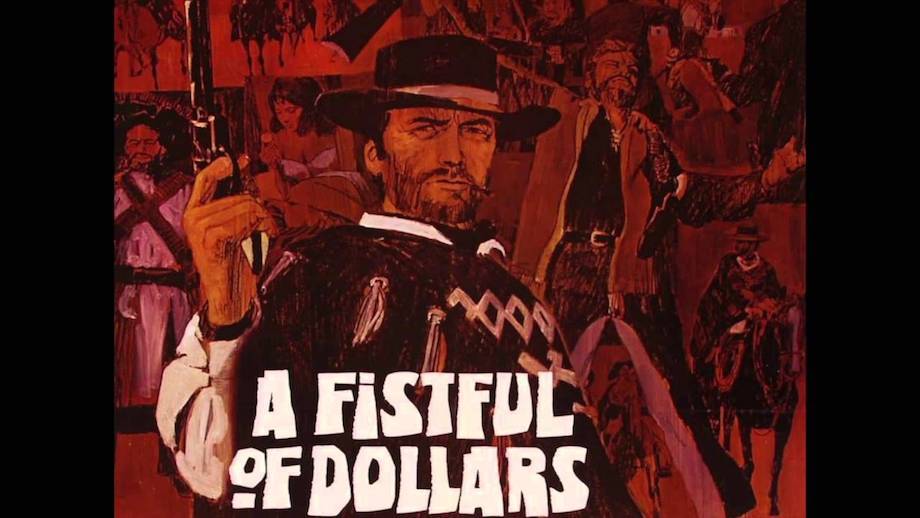 A Fistful of Dollars (1964)
A Fistful of Dollars (1964)
Just like Wayne, Clint Eastwood languished in Poverty Row, only in the 1950s it was called television.
Playing the second lead character, Rowdy Yates, in Rawhide, he had a respectable following but no one ever figured he’d become one of the biggest Hollywood stars of all time. A Fistful of Dollars changed all that and the rest, as they say, is history.
I’ve already remarked in a previous article about how cinema audiences were stunned when A Fistful of Dollars was released only to see that nice Rowdy Yates turning up as a ‘monosyllabic psychopath with no name who shoots first and doesn’t bother asking questions afterwards’.
Actually, he does have a name. He’s called Joe but The Man With No Name has more of a ring to it.
A Fistful of Dollars wasn’t released in the UK until 1967 despite having been released in Italy in 1964. This delay was in part due to Japanese director Akira Kurosawa suing Italian director Sergio Leone for stealing the story from Kurosawa’s samurai movie Yojimbo.
Kurosawa walked away with a lot of money, and Leone ended up getting A Fistful of Nothing for directing the film, although he more than made up for that with the two films that completed the Dollar Trilogy.
The story involves stranger Joe riding into a town controlled by two factions, the Baxters and the Rojos.
He plays one gang off against the other, the Rojos eventually eliminating the Baxters, and Joe doing the same to the Rojos. In between all of this there’s a subplot involving a kidnapped woman who Joe rescues and returns to her husband and son, indicating that the unforgiving killer actually has a soft spot.
Just to show he’s also vulnerable, Joe gets the excrement kicked out of him by the Rojos, accompanied as usual by a cacophony of unfiltered chuckling and chortling on behalf of the permanently amused gang members.
Watching it again I’m still struck, as I was when I first saw the film, by Sergio Leone’s cartoonish approach to the Western.
It’s halfway between parody and pastiche, with dying cowboys twisting like tops and throwing their arms into the air like children might do when pretending to be shot.
This notion of play-acting is reinforced by the complete absence of blood in the gunfight scenes. One character even suggests that it’s like ‘playing cowboys and Indians’, a line that I’m assuming is supposed to be ironic.
The film also throws in the standard cliché of Mexicans forever laughing uncontrollably whenever they drink, shoot or maim. It’s like a laughing gas canister has exploded in their midst and they just can’t control themselves.
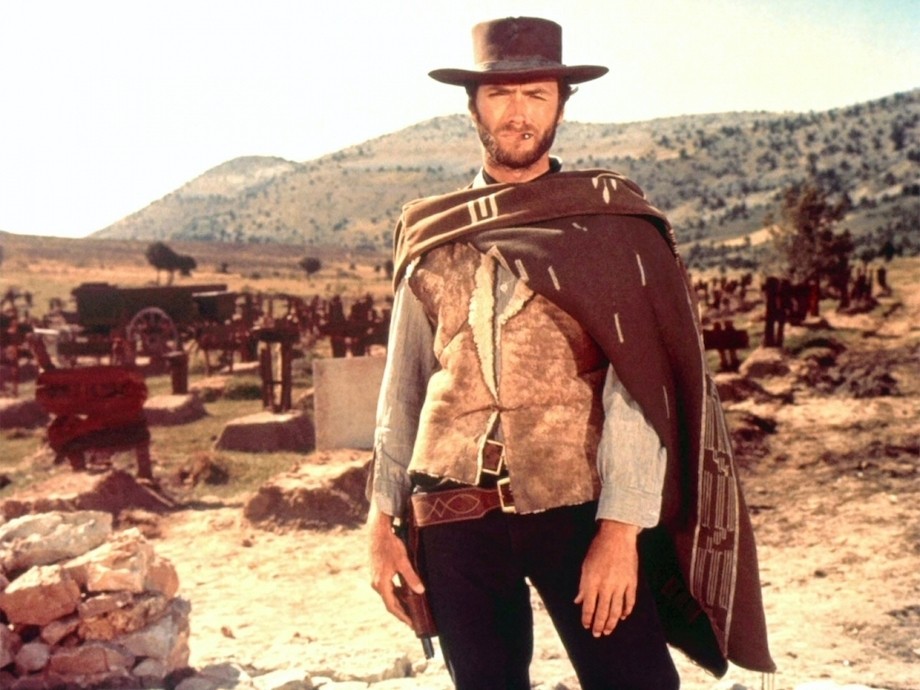
Until The Man With No Name turns up of course and wipes the smile from their faces, and then they laugh no more.
I should mention in dispatches the innovative sound of Ennio Morricone’s soundtrack, or Dan Savio as he was known in the original credits for the film.
Leone was called Bob Robertson and the magnificently over-the-top villain, Gian Maria Volonte, was known as John Wels, a name I notice he was still associated with on the 1968 soundtrack release.
A Fistful of Dollars is an extremely entertaining and ground-breaking film to watch and Westerns were never really the same after this – I’ll leave you to consider if that was good, bad or just plain ugly.
After all these years I’m still undecided myself but on the positive side it made a star out of Clint Eastwood, an actor who showed he was a worthy successor to the likes of Wayne, Alan Ladd, Randolph Scott and James Stewart when it came to the Western.
The only difference between them and Eastwood is that he spoke less and shot more people.
For those who might not be aware, the story for Yojimbo was used again in 1996 as the basis for the Bruce Willis gangster film, Last Man Standing.
Although it didn’t do that well at the box office I quite like it, and Kurosawa, along with scriptwriter Ryuzo Kikushima, finally got the credit they deserved.
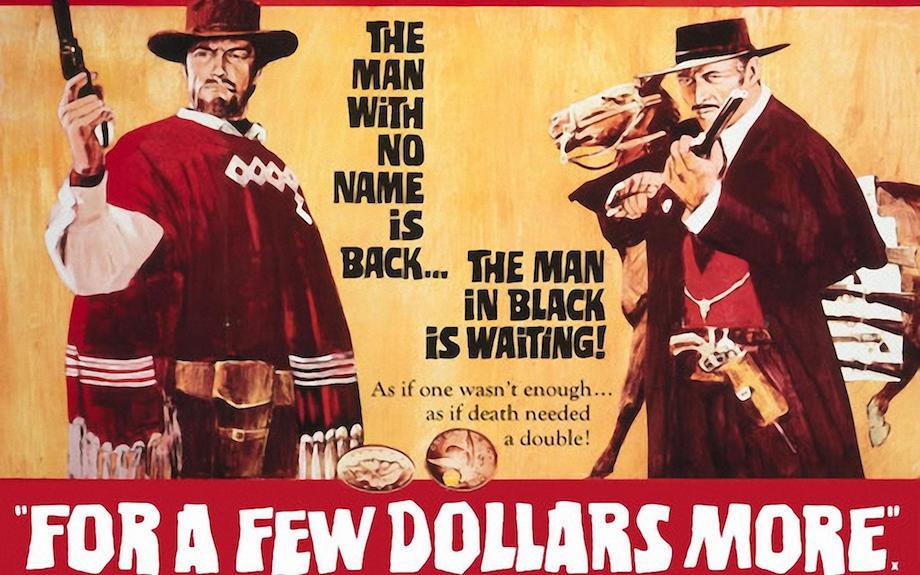 For a Few Dollars More (1965)
For a Few Dollars More (1965)
In the second of the Dollar trilogy, Eastwood returned as The Man With No Name, playing a poncho-wearing silent killer with an unlit cigarillo clenched between his teeth.
In other words, just like the character he played in A Fistful of Dollars, although for some reason he’s called Monco, not Joe. Other than that it’s business as usual.
This time round though, Eastwood is joined by veteran Hollywood Western actor Lee Van Cleef, playing a pipe-smoking bounty hunter, Colonel Douglas Mortimer, who competes with Eastwood in the killing stakes. As A Fistful of Dollars did with Clint, this film finally propelled Van Cleef into much deserved popularity and stardom and boy, did he make the most of it.
The real star of the film, however, is Gian Maria Volonte, reprising his psycho Mexican bandit performance from A Fistful of Dollars, as Indio.
If possible he’s even nastier than he was in the first film, smoking dope to calm his nerves whilst reminiscing on the time he raped a young woman who subsequently killed herself.
The scene in which he forces a man to listen whilst his wife and young child are murdered to the accompaniment of a stolen timepiece – musical chimes courtesy of Ennio Morricone – before then shooting the unfortunate husband is genuinely chilling to watch.
You’re just aching for the moment for Indio to get his just desserts, which he finally does at the end of this 2 hour 12-minute opus.
My favourite moment in the movie is when Van Cleef strikes a match on Klaus Kinski’s bearded cheek, Kinski playing a hunchbacked gang member called Wild.
In response to this outrage he sweats and twitches like a long-tailed cat in a room full of rocking chairs (that was the least offensive metaphor I could find). If twitching and sweating were an Olympic sport, then Kinski would take win gold every single time. Despite this obvious talent, Van Cleef eventually shoots him anyway.
Apart from Gian Maria Volonte, a couple of other familiar faces from the previous film also turn up, including Maria Brega and Josef Eggar.
What also turns up is yet another example of “let’s beat the living daylights out of Clint Eastwood” to yet another soundtrack of uproarious laughter.
The final gunfight sequence, in which Mortimer gets to avenge his sister, the girl Indio had raped, looks like a rehearsal for the closing scene in the final part of the trilogy. Speaking of which….
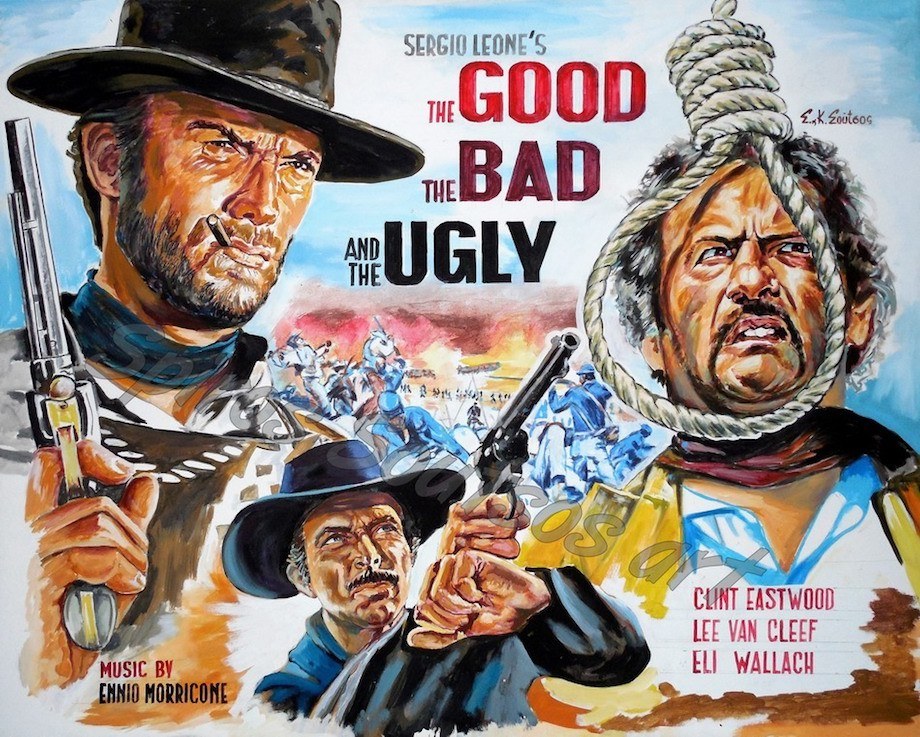
The Good the Bad and the Ugly (1966)
This is it. This is the one. As Quentin Tarantino maintains, The Good, the Bad and the Ugly is ‘cinematically perfect’. I wholeheartedly agree.
Not for me the sombre aesthetic of Once Upon a Time in the West or the ‘amoral non-engagement’ – I know, I have no idea what that means either – of Duck You Sucker (aka A Fistful of Dynamite).
Sergio Leone’s final entry in the Dollar trilogy is without doubt the best Western he ever made. It runs just short of 3 hours and I could watch it multiple times and never get bored. It’s got a great cast and is also blessed with the best soundtrack Ennio Morricone ever wrote, bar none.
The opening sequence pre-echoes the beginning of Leone’s Once Upon a Time in the West, with Al Mulock, the actor who also plays one of the ill-fated trio in the later film, facing into the camera as he and two other killers close in on the bandit Tuco, played by Eli Wallach.
Tuco blasts all three of them then jumps through a glass window, his image freeze-framed along with the description as “Ugly”. Lee Van Cleef as bounty hunter Angel Eyes turns up next, and we know he’s going to be “Bad” after he shoots someone in the face through a pillow four times.
It’s a whole seventeen minutes before Clint, as Blondie, finally graces the screen, and within sixty seconds he’s already shot three men.
And he’s supposed to be the “Good” one?
Although there’s an attempt to restrain the annoying constant laughter of the villains that on occasion blights the earlier films in the trilogy, Eli Wallach takes it upon himself to deliver lots of out of context giggling in a shamefully scene-stealing role as Tuco.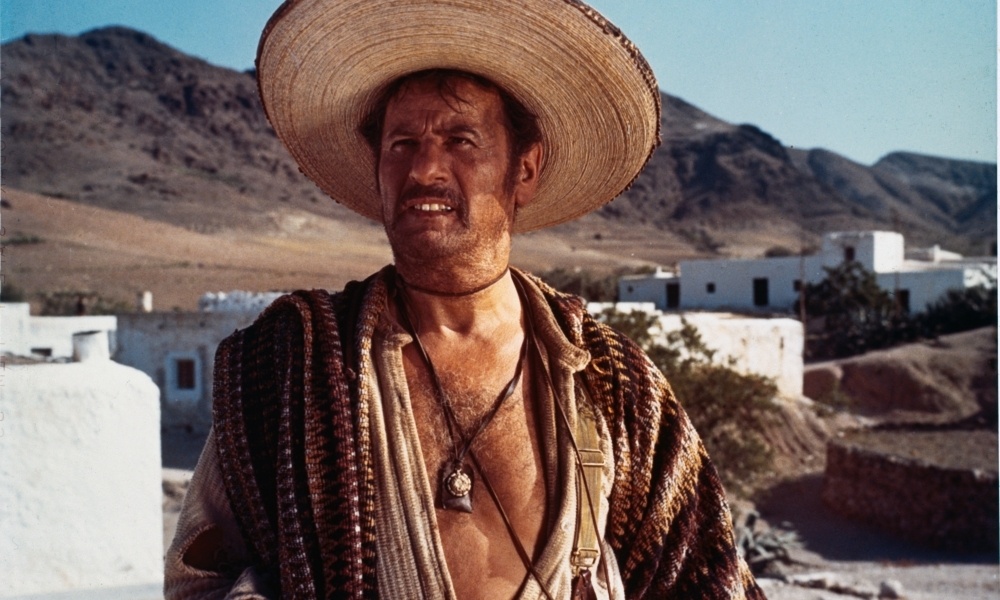
Van Cleef is not as benign as bounty hunter Mortimer in For a Few Dollars More, but Clint’s character displays a bit more compassion than usual.
We see him stroking a kitten, helping a dying Union colonel by blowing up a bridge just as the colonel passes away, and giving away his coat to a dying soldier. In this last example Blondie exchanges the coat for the poncho he wore as Joe and Manco.
Another familiar face is Mario Braga, the guy who gets crushed by a huge wooden barrel in A Fistful of Dollars, stabbed in the back by psycho bandit leader Indio in the second film and here having his head smashed on a rock before being run over by a train.
He and Sergio must have been really good friends.
Although the story is set against the American Civil War, the main theme of The Good, the Bad and the Ugly is that of the previous Dollar entries, in which the characters keep double-crossing each other over and over and over again until only the good, or in this case the good and the ugly, are left still standing.
It would take another article just to go through the plot but in essence the three main protagonists are all looking for a cache of money, two-hundred-thousand dollars to be exact, which has been buried in a cemetery called Sad Hill.
You could argue it’s an update of The Treasure of the Sierra Madre, only somewhat more violent in the retelling.
I watched the restored extended version that was released on DVD a few years back but to be honest most of the extra sequences don’t really bring much to the table.
The one exception is the section in which Tuco takes Blondie to a monastery – Blondie needs to recuperate after Tuco has forced him to trek through the desert without water – and it turns out that Father Ramirez, the head priest, is actually Tuco’s brother.
Apparently Leone used demo versions of Morricone’s music to choreograph the two sequences at the end of the film, the first in which Tuco frantically runs around Sad Hill cemetery to the strains of The Ecstasy of Gold.
The second scene, in which Blondie, Angel and Tuco face off in a gunfight with the winner taking the money, is accompanied by a Morricone composition called The Trio.
Along with those two compositions, as well as the iconic title track and the unbearably sad Story of a Soldier, I’m surprised no one has yet put on a showing of the film with a live orchestra. I’d be first in line if that ever happened.
In the meantime, I’m just happy to have had the opportunity to see Ennio Morricone in concert twice in the last ten years or so. The man is a bona fide genius, as was Sergio Leone, and The Good, the Bad and the Ugly is their finest collaboration, and their finest moment.
Some of you Clint / Sergio / Ennio / Dollar trilogy fans out there might want to know that a few years ago a group of like-minded individuals located and restored the set for Sad Hill cemetery, located 150 miles north of Madrid in Spain.
In order to help finance the project they are offering, for a fee of course, to put your name on one of the crosses in the cemetery. 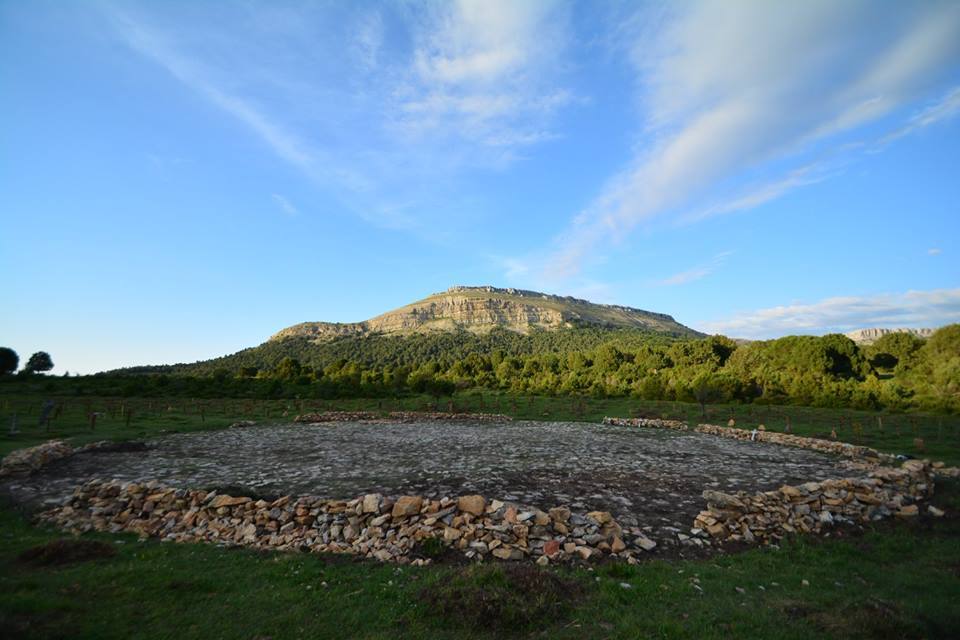 If you’re interested – and I’ve already reserved my plot – find out more here.
If you’re interested – and I’ve already reserved my plot – find out more here.
Altogether now; Aye iy aye iy aye – wah wah wah.
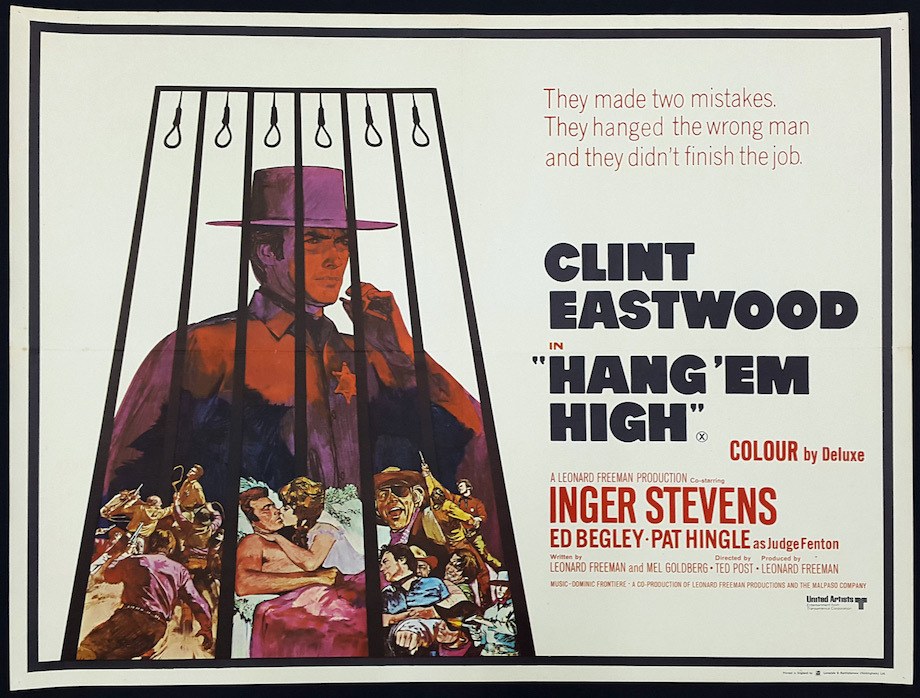
Hang ‘Em High (1968)
Seeing as Clint has on occasion expressed his admiration for The Oxbow Incident, a 1940s Western dealing with the lynching of three innocent men accused of rustling, it comes as no surprise that the beginning of Hang ‘Em High opens with the lynching of Mr. Eastwood himself.
As the blurb on the poster declared, “They made two mistakes. They hanged the wrong man and they didn’t finish the job”. If they only knew.
Seeing as this is the first Western that Eastwood starred in after the success of the Dollar trilogy there are obvious similarities between the Leone movies and this Hollywood opus.
The first thing that strikes you is how much the main theme by Dominic Frontiere samples Morricone’s use of bells and guitar, almost as if Frontiere is auditioning for Leone’s next Western.
Throw in the almost casual regard for human life that one found mainly only at that time in the so-called “Spaghetti” Westerns and you have one of the first Hollywood attempts at an Italian-style cowboy film.
Where Hang ‘Em High wins out over the pretend Italian cowboy films is a wonderful supporting cast who embody all that Sergio Leone and his fellow Italian directors were unable to replicate, no matter how many actors they managed to import from America, namely genuine Western character actors.
Apart from the wonderful Ben Johnson there’s also Dennis Hopper, L.Q. Jones, Charles McGraw and last, but definitely not least, a certain Bruce Dern, four years before his career-breaking role as John Wayne-killer Asa Watts in The Cowboys.
This being a Clint Eastwood film you just know he’s not going to rest until he tracks down the men who tried to lynch him, his character Jed Cooper taking up the offer after he’s been cut down from the hanging tree by Ben Johnson to become an official Marshall.
This enables him to catch the bad guys lawfully, which he does with gusto. It all turns a bit sour for Jed though when Judge Fenton, played by Pat Hingle, insists on stringing up a couple of young boys who joined in with Bruce Dern on a rustling spree.
The public hanging sequence is the centre-piece of the film, and I have to admit that the execution of the two young boys is still hard to watch. I’d go so far as to say it leaves a bit of a nasty taste in the mouth as their characters don’t really deserve to die, not in such a manner anyway.
After that the film, for me anyway, kind of goes downhill.
Cooper tracks down the men who tried to lynch him at the beginning of the film, the leader of the gang taking the easy way out by hanging himself rather than face judicial execution in front of a large crowd.
A few loose ends are tied up, Cooper gets the girl and then that’s it really.
Upon reflection the transition from Italian Western cowboy star to big-screen Hollywood cowboy stardom was not necessarily guaranteed with Eastwood’s first foray into the genre after working on the Dollar trilogy.
Maybe a better choice of director might have helped, Ted Post having worked more in TV than feature films, although Eastwood had no problem working with him again on the second Dirty Harry movie, Magnum Force.
Still, we have to be thankful for small mercies. At least Clint didn’t decide to do McKenna’s Gold instead after The Good, the Bad and the Ugly. That would have killed his return to Hollywood dead in its tracks.
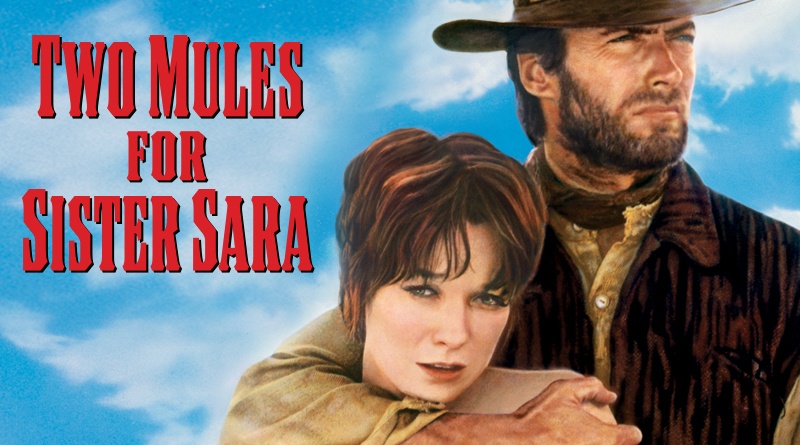
Two Mules for Sister Sara (1970)
I don’t really remember ever having previously seen Two Mules for Sister Sara all the way through to the end so it was a bit of a voyage of discovery when watching it for the purpose of this review.
It starts promisingly. Over the credits you can hear what I initially thought was an attempt at a Morricone-type soundtrack only to be completely surprised to see that it actually is Ennio holding the composing reins himself. Apparently this was his first complete score for a Hollywood film.
The Dollar / Leone vibe continues with Clint, a wandering ex-soldier referred to only as Hogan, rescuing a nun, played by Shirley MacLaine, from being raped by three bandits.
Clint shoots all three of them dead, so par for the course so far.
Unfortunately, after such a promising beginning, Clint doesn’t actually get to kill anybody else for at least another hour and a half.
I’m assuming the train he later blows up with the help of Ms. MacLaine probably had a whole bunch of passengers on it but, just as when we watch a John Wayne film, we pay to see Clint doing what he does best, and that’s blowing away as many of the bad guys as he possibly can before the end credits roll.
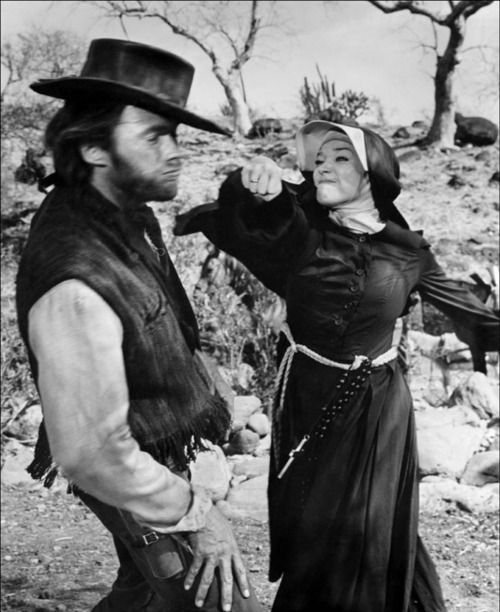 Based on a script by Western director Budd Boetticher, a better title would have been something like The Nun and the Gunfighter, or Hogan and the Sister maybe, which is the reason I found this film a bit disappointing.
Based on a script by Western director Budd Boetticher, a better title would have been something like The Nun and the Gunfighter, or Hogan and the Sister maybe, which is the reason I found this film a bit disappointing.
It’s an attempt at the type of stuff they used to make back in the 1930s / 1940s, such as The Cowboy and the Lady and The Lady Takes a Chance, in which a mismatched couple are constantly at loggerheads until they inevitably fall into each others arms by the end of the movie.
This is the second film in which Clint is directed by Don Siegel. The first was Coogan’s Bluff, a kind of modern-day Western set in New York, which supposedly inspired the Dennis Weaver TV series, McCloud.
Actor and director would go on to make The Beguiled, which, although set during the American Civil War, is not so much a Western, more a sexually charged tale of rooster Clint running riot in a henhouse of a girl’s school in antebellum Mississippi.
Their final film together, Dirty Harry, is definitely the best of the bunch. Siegel eventually managed to put his name to a genuine classic Western a few years later when he got to direct John Wayne in The Shootist.
Right from the start I never bought the idea that Shirley was actually a real nun, which it eventually turns out she isn’t.
Having said that, I found her rather more alluring as a nun than as a lady of the night, but maybe that’s just my sick mind.
The film picks up in the final 20 minutes or so, when the Mexican Juarista’s take on the occupying French forces and a lively battle ensues.
Clint uses lots of explosives to help kill the French army – maybe they should have called it A Fistful of Dynamite instead, what with him constantly puffing on a cigarillo as if he was still The Man With No Name.
On the whole, it’s a bit of a waste of all the talents involved, with Clint still trying to get into his stride as a genuine Hollywood cowboy after the success of the Leone trilogy. I’ll put it down to a learning experience and leave it at that.
Keep your eyes peeled and your rifle locked and loaded for part 2 of the Westerns of Clint Eastwood.
